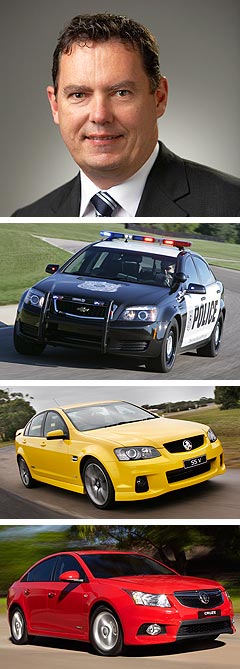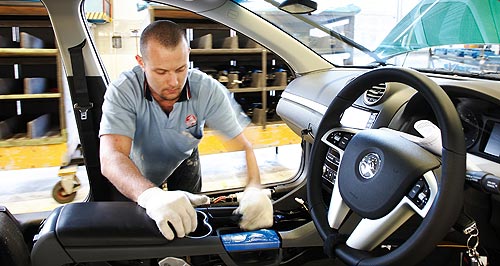Make / Model Search
News - HoldenHolden looks to reverse workforce shrinkageNot all doom and gloom: Holden says its Elizabeth plant in South Australia accounts for 265 of the 600 jobs secured for local Cruze production. While others chop jobs, Holden hopes to stop the rot and finally grow its payroll15 Apr 2011 GM HOLDEN hopes the decades-long decline in its workforce numbers has not only bottomed out but will reverse with prospects for increased production of its Cruze small car and Commodore large car and its Chevrolet derivatives. In a week when its rival Ford announced it would cut 240 jobs at its Victorian factories at Broadmeadows and Geelong due to slow Falcon sales and Toyota cut production due to parts shortages in the wake of the Japanese earthquake and tsunami, Holden said it hoped to add more workers as production increased at its Elizabeth plant in South Australia. The company says the Cruze program has already secured jobs for about 600 employees across the company, with almost half of them – 265 – being added at the Elizabeth vehicle factory in South Australia. It claims a further 600 jobs were also created in its supply chain. The company is increasing production of the Caprice Police Pursuit Vehicle (PPV) as more successful tenders from North American law enforcement agencies are locked in, and will bring the locally designed Cruze five-door hatch on stream alongside the Cruze sedan later this year.  From top: GM Holden chief financial officer Mark Bernhard, Chevrolet Caprice PPV, Holden Commodore, Holden Cruze. From top: GM Holden chief financial officer Mark Bernhard, Chevrolet Caprice PPV, Holden Commodore, Holden Cruze.American reports suggest a civilian Chevrolet ‘SS Sedan’ version of the Commodore has also been approved for the United States as a 2014 model, when the next Commodore, the VF, is also due to roll off the production line. GM Holden chief financial officer Mark Bernhard said this week when announcing Holden’s return to profitability in 2010 after five years in the red that rather than just stabilise its employment numbers since the global financial crisis, it had increased its head count. “We have certainly seen it bottom out I guess, and we are looking to increase where we can increase production,” he said. But Holden says it reduced its workforce from 6368 in October 2008 to 4815 today under its post-GFC restructuring, despite adding extra workers for Cruze. About 1500 of those lost workers were made redundant with the closure of the third shift at the Elizabeth plant after the demise of the Pontiac G8 export program and collapse of Chevrolet export volumes to the Middle East in the GFC in 2009, while a further 500 lost their jobs with the scheduled closure of the four-cylinder engine plant at Port Melbourne in early 2009. To stave off further redundancies, the company reduced its two-shift Elizabeth plant to one shift, with workers sharing the remaining shift on 75 per cent pay. The second shift was restored at the end of last year as Commodore sales recovered and the factory geared up for Cruze and PPV production starting this year. As well, Holden increased V6 engine production at its Port Melbourne plant last year to meet increased export demand from China, South Korea and Mexico, adding a second shift and 19 extra employees in about April. Last year, Holden exported about 7800 vehicles, mainly to New Zealand and the Middle East – well down on its peak of more than 60,000 vehicles in 2005 when Pontiac GTO shipments to the US and Chevrolet exports to the Middle East were running strongly. Mr Bernhard said the Chevrolet PPV would help to lift those numbers this year, along with exports to Brazil and South Africa. However, he was gloomy about the prospects of resuming previous levels of exports to the Middle East. “Certainly not within our planning horizon are we looking at getting back to the levels that they were,” he said. “We continue to work closely with our Middle East organisation, with General Motors, to drive as much volume as we can, as they look to their portfolio of products in the market.” Mr Bernhard said the strong Australian dollar was obviously challenging, particularly for the export business. “We tend to look at it more holistically, taking into account imports of components and imports of vehicles and also pricing in the market as well,” he said. “It is obviously complex, and the risk inherent in foreign exchange is one that we continually need to be vigilant on. “At this stage, we are fairly confident with where we are at on exchange rates. We continue to work on export programs as much as possible.” Mr Bernhard said that on exchange rates, Holden looked to “a long-term Aussie dollar with an eight in front of it”, but said Holden’s business plans were not bound to an 80-cent Australian dollar. “Our plans around retaining profitability are first and foremost to make sure we have a profitable domestic operation here locally, and we will deal with the exchange rates as they change,” he said. “Certainly it has been extremely volatile in the period we have looked at, going from mid-90s down to mid-60s and then back again. “We will continue to monitor it closely, but certainly we are focused here on making sure we have got a profitable organisation domestically.” Mr Bernhard said Holden’s $112 million after-tax profit from 2010 would be reinvested in the Holden business, rather than be siphoned off to parent company GM. “We haven’t paid a dividend,” he said. “We have chosen instead to reinvest in the business, largely around the Cruze. So that all stays in Australia.” Holden’s workforce peaked in the 1970s when hits such as the Holden HQ provided jobs for about 20,000 workers across six factories in several states, including New South Wales. Holden’s Pagewood plant in Sydney closed in the early 1980s, while its Dandenong factory shut its doors in the mid-1990s after a brief period building the Toyota Corolla and its re-badged Holden namesake, the Nova, under the ill-fated Toyota-Holden joint-venture. In 2000, Holden four-cylinder car production came to an end with the death of the locally-made Vectra at Elizabeth, and then the Holden Engine Company’s Family II four-cylinder engine plant went two years ago. However, Holden opened a $400 million Global V6 engine plant next door to the four-cylinder plant in 2003, exporting engines to Europe, China, South Korea and Mexico, as well as making V6s for the Commodore and its derivatives.  Read more12th of April 2011  Red team back in blackHolden fights back with a $112 million profit, ending five years of losses30th of March 2011  Holden’s American Chevrolet program ‘approved’US website says GM documents reveal green light for Holden ‘Chev SS Sedan’ exports |
Click to shareHolden articlesResearch Holden Motor industry news |











Facebook Twitter Instagram